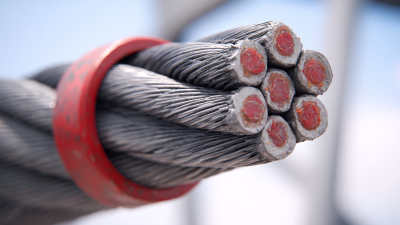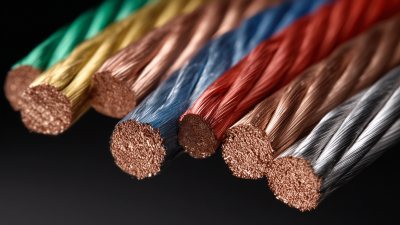In today's rapidly evolving energy landscape, the demand for enhanced power distribution efficiency is at an all-time high. According to a report by the International Energy Agency, global electricity demand is expected to increase by 30% between now and 2040, which necessitates advanced solutions in power transmission. High voltage cables play a crucial role in this framework, as they are designed to transport large volumes of electricity over long distances with minimal losses. As the industry shifts towards renewable energy sources, the need for reliable and efficient high voltage cable solutions becomes even more critical. This ultimate guide explores the top five high voltage cable solutions that not only enhance power distribution efficiency but also cater to the growing demands of modern energy systems, ensuring stability and sustainability in the power supply.

In the age of modern power distribution, the role of high voltage cable innovations cannot be overstated. These technologies are transforming the landscape of the electrical grid, enhancing not only efficiency but also reliability. With a variety of materials available, including advanced insulation solutions like cross-linked polyethylene and polyvinyl chloride, manufacturers are developing cables that are better equipped to handle the complexities of today's energy demands. This evolution is critical as we shift towards more sustainable and efficient energy solutions, reducing transmission losses and increasing operational longevity.
Smart grids, which utilize digital technologies and real-time data analytics, are being integrated alongside these high voltage cable advancements. By employing sensors and sophisticated software, smart grids enable a more dynamic response to electricity supply and demand, further enhancing distribution efficiency. As utilities increasingly invest in these innovative solutions, the interplay between high voltage cables and smart grid technologies promises to revolutionize how energy is distributed, ensuring that it meets the needs of a growing population while minimizing environmental impact.
High voltage cables are a critical component in power distribution systems, where their materials significantly influence both efficiency and durability. The choice of material—whether it be copper, aluminum, or advanced composites—plays a crucial role in minimizing energy losses during transmission. For instance, copper cables, known for their excellent conductivity and resistance to oxidation, can enhance efficiency in power distribution. In contrast, aluminum cables offer a lightweight alternative, which can be advantageous in specific applications, despite their slightly higher resistance.
Furthermore, recent research has explored how environmental factors impact the longevity of these high voltage cables. Studies indicate that harsh conditions such as extreme temperatures, humidity, and exposure to corrosive substances can degrade cable materials over time. Innovative approaches are being developed to quantify these effects and enhance the cable design process. By integrating advanced coating technologies and composite materials, manufacturers can improve the resilience of these cables, ensuring reliable performance in challenging environments. Thus, as the demand for efficient and durable power distribution solutions grows, the significance of material selection becomes increasingly apparent.

In the evolving landscape of power distribution, the choice between conventional and advanced high voltage cable solutions plays a crucial role in optimizing system efficiency. Conventional solutions often rely on traditional ampacity evaluation methods that may not fully account for the increasing demand for power and the complexities of modern electrical systems. These methods typically involve basic calculations based on material properties and environmental conditions, which can lead to an underestimation of the actual conductor capacity under varying operational conditions.
On the other hand, advanced high voltage cable solutions incorporate sophisticated ampacity evaluation techniques. These modern methods utilize dynamic modeling and real-time data analytics to enhance conductor performance assessments. For instance, advanced simulations and thermal monitoring can better predict how cables will behave under stress, leading to more reliable and efficient power distribution. By adopting these innovative approaches, utilities can not only optimize the performance of their infrastructure but also reduce energy losses and improve overall grid stability. The comparative analysis of these two approaches highlights the importance of embracing technological advancements in the electrical industry to meet future power demands effectively.
As the demand for efficient power distribution continues to rise, superconductors have emerged as a pivotal technology in enhancing transmission capacity. These materials allow electricity to flow without resistance, significantly reducing energy losses that typically occur in conventional cables. By adopting superconducting cables, utility companies can handle greater loads while minimizing the footprint of their infrastructure. This not only optimizes existing power networks but also supports the integration of renewable energy sources.
Tip: When considering the implementation of superconductors in your power project, be sure to analyze the cooling requirements and overall lifecycle costs. Although initial investments may be higher, the long-term savings in energy efficiency can offset these expenses.
Moreover, superconductors offer advantages in urban settings where space is limited. Their ability to carry high currents over long distances without heat generation means that they can be installed underground or in otherwise unused spaces, thus optimizing land use. This innovative approach can help tackle the challenges posed by growing urban populations and their energy needs.
Tip: Collaborate with experienced engineers who specialize in superconducting technologies to ensure that your project is designed for maximum reliability and efficiency. Engaging with experts early in the design process can help smooth out potential challenges.
The landscape of high voltage cable solutions is continually evolving, driven by emerging regulatory trends and standards that shape the industry's best practices. One of the most significant factors influencing these developments is the push towards enhanced safety and environmental sustainability. Governments and regulatory bodies are implementing stricter norms to ensure that high voltage cables meet rigorous safety specifications while minimizing their ecological footprint. This regulatory environment compels manufacturers to innovate, resulting in solutions that not only comply with safety mandates but also incorporate environmentally friendly materials and processes.

Moreover, the shift towards renewable energy sources is also creating a demand for advanced high voltage cable systems. As industries transition to more sustainable power generation methods, regulations are being updated to facilitate the integration of these technologies into the existing electrical infrastructure. Standards are being developed to support new designs that allow for efficient energy transmission over long distances, crucial for connecting remote wind and solar farms to urban centers. As a result, high voltage cable alternatives must adhere to these evolving guidelines, ensuring reliability, efficiency, and the ability to support grid resilience in a changing energy landscape.





